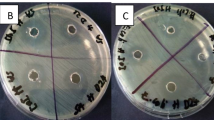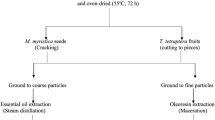Abstract
The sterols, hydrocarbons and fatty acids constituents of the leaves of five mango cultivars locally implanted in Egypt were identified. The effect of their essential oils (EOs) against food borne microorganisms was studied as preservative materials. The chemical constituents of the EOs isolated from mango leaves were identified by Gas Chromatography–Mass spectrometry (GC–MS) technique. Trans-caryophyllene, α–humulene and α–elemene were identified as terpene hydrocarbons, while 4-hydroxy-4-methyl-2-pentanone as oxygenated compounds were recorded in all tested cultivars with variable amounts. Results showed that Staphylococcus aureus and Escherichia coli were the most sensitive microorganisms tested for Alphonso EOs. On the other hand, Salmonella typhimrium was found to be less susceptible to the EOs of the studied cultivars. The EOs of different mango cultivars induced a steady decrease in the activity of amylase, protease and lipase at the minimum inhibitory concentration (MIC). The treatment of the tested bacteria with the EOs of mango cultivars caused a steady loss in enterotoxins even when applied at the sub-MIC. Bacteria-inoculated apple juice treated with minimum bactericidal concentration of Alphonso oil was free from the bacteria after 5 days of incubation at 25 °C. Eighteeen volatile compounds were found to reduce the activity of the amylase enzyme and the most active was cedrelanol (−7.6 kcal mol−1) followed by alpha-eudesmol (−7.3 kcal mol−1) and humulene oxide (−7 kcal mol−1). The binding mode of both of cedrelanol and alpha-eudesmol with amylase enzyme was illustrated.
Similar content being viewed by others
References
Abdalla AEM, Darwish SM, Ayad EHE, El-Hamahmy RM (2007) Egyptian mango by-product 1. Compositional quality of mango seed kernel. Food Chem 103:1134–1140
Abhishek BR, Venkataraghavan R, Vivek P, Ivo RS (2019) Molecular docking of various bioactive compounds from essential oil of Trachyaspermum ammi against the fungal enzyme Candidapepsin-1. J Appl Pharm Sci 9(05):021–032
Ahmed HH, Abd-Rabou AA, Hassan AZ, Kotob SE (2015) Phytochemical analysis and anti-cancer investigation of boswellia serrata bioactive constituents in vitro. Asian Pac J Cancer Prev 16(16):7179–7188
Chandrasekaran M, Venkatesalu V (2004) Antibacterial and antifungal activity of Syzygiumjambolanum seeds. J Ethnopharmacol 91:105–108
Chang CW, Chang WL, Chang ST, Cheng SS (2008) Antibacterial activities of plant essential oils against Legionella pneumophila. Water Res 42:278–286
Claveiro AA, Andrade CHS, Matos FJA, Alencar JW, Machado MIL (1980) Volatile constituents of Mangifera indica Linn. Rev Latinoam Quim 11(3–4):129
CLSI (2012). Methods for Dilution Antimicrobial Susceptibility Tests for Bacteria that Grow Aerobically, Approved Standard, 9th ed., CLSI document M07-A9. Clinical and Laboratory Standards Institute, 950 West Valley Road, Suite 2500, Wayne, Pennsylvania 19087, USA
Davidson PM, Parish ME (1989) Methods for testing the efficacy of antimicrobials. Food Technol. 52:148–154
de Carvalho PM Jr., Rodrigues RFO, Sawaya ACHF, Marques MOM, Shimizu MT (2004) Chemical composition and antimicrobial activity of the essential oil of Cordia verbenacea. J Ethnopharmacol 95:297–301
Duresa LW (2017) Phytochemical screening and antioxidant activity of selected mango (Mangifera indicaL.) and avocado (Persea Americana) fruits in Illu Ababor Zone, Oromia regional state, Ethiopia. IOSR J Appl Chem 10(5):24–28
Engel KH, Tressl R (1983) Studies on the volatile components of two mango varieties. J Agric Food Chem 31:796–801
Fadel HHM, Hassan IM, Ibraheim MT, Abd MA, El Mageed MA, Saad R (2019) Effect of using cinnamon oil encapsulated in maltodextrin as exogenous flavouring on flavour quality and stability of biscuits. J Food Sci Technol 56:4565–4574
Gaydou EM, Bouchet P (1984) Sterols, methyl sterols, triterpene alcohols and fatty acids of kernel fat of different Malagasy mango (Mangifera indica L.) varieties. JAOCS 61(15):1589–1593
Hassan AZ, Ahmed KM, Abu-Gabal NS, Mahrous KF, Shalaby NMM (2017) Phytochemical and genotoxicity studies of Citrus reticulate aerial part in mice. Egypt Pharm J 16:87–97
Idstein H, Schreier P (1985) Volatile constituents of Alphonso mango (Mangifera indica). Phytochemistry 24(10):2313–2316
Jette JF, Ziomek E (1994) Determination of lipase activity by a rhodamine triglyceride agrose assay. Anal Chem 219:256–260
Kang DH, Fung DYC (2000) Application of thin agar layer method for recovery of injured Salmonella typhimurium. Int J Food Microbiol 54:127–132
Khedr MA, Emad AE, Khalil KMA (2017) Overproduction of thermophilic α-amylase productivity and Amy E gene sequence of novel Egyptian strain Bacillus licheniformis MK9 and two induced mutants. Curr Sci Int 6(2):364–376
Kuspradini H, Egra S, Wulandari I, Putri AS (2018) Chemical composition and bioactivity of essential oil from the leaves of Scorodocarpus borneensis Becc. (Olacaceae) grown in Indonesia. Asia Life Sci 27(2):343–353
Leja K, Szudera-Kończal K, Myszka K, Czaczyk K (2019) Antibacterial effect of natural oils- an opportunity to solve the problem of antibiotic resistance on the example of Pseudomonas spp. Postep Mikrobiol 58:177–190
Lowry OH, Rosebrough NJ, Farr AL, Randall RJ (1951) Protein measurement with the Folin phenol reagent. J Biol Chem 193:265–275
Lozano-Grande MA, Gorinstein S, Espitia-Rangel E, Da´vila-Ortiz G, Mart ınez-Ayala AL (2018) Review article plant sources, extraction methods, and uses of squalene. Int J Agron, Article ID 1829160, p 13
Maurmanna N, de Fariasa CB, Schwartsmannc G, Roeslera R, Hernándezg RD, Pardo-Andreu GL (2014) Mangifera indica L. extract (Vimang) improves the aversive memory in spinocerebellar ataxia type 2 transgenic mice. J Pharm Pharmacogn Res 2(3):63–72
Memar MY, Raei P, Alizadeh N, Aghdam MA, Kafil HS (2017) Carvacrol and thymol: strong antimicrobial agents against resistant isolates. Rev Med Microbiol 28(2):63–68
Mittal RP, Rana A, Jaitak V (2019) Essential oils: An impending substitute of synthetic antimicrobial agents to overcome antimicrobial resistance. Curr Drug Targets 20(6):605–624
Ngome MT, Alves JGLF, de Oliveira ACF, Machado PS, Mondragón-Bernal OL, Piccoli RH (2018) Linalool, citral, eugenol and thymol: control of planktonic and sessile cells of Shigella fexneri. AMB Expr 8:105
Nostro A, Bisignano G, Cannatelli MA, Crisaf G, Germano MP, Alonzo V (2001) Effects of Helichrysum italicum extract on growth and enzymatic activity of Staphylococcus aureus. Int J Antimicrob Agents 17:517–520
Oboh G, Agunloye OM, Adefegha SA, Akinyemi AJ, Ademiluyi AO (2015) Caffeic and chlorogenic acids inhibit key enzymes linked to type 2 diabetes (in vitro): A comparative study. J Basic Clin Physiol Pharmacol 26(2):165–170
Ouf SA, Mohamed A-AH, El-Sayed WS (2016) Fungal decontamination of fleshy fruit water washes by double atmospheric pressure cold plasma. Clean: Soil, Air, Water 44(2):134–142
Ouf SA, Yehia RS, Ouf AS, Abdul-Rahim RF (2018) Bacterial contamination and health risks of drinking water of the municipal non-government managed water treatment plants. Environ Monit Assess, vol 190, article 685
Pandey AK, Kumar P, Singh P, Tripathi NN, Bajpai VK (2017) Essential oils: sources of antimicrobials and food preservatives. Front Microbiol 7:2161. https://doi.org/10.3389/fmicb.2016.02161
Park SN, Lim YK, Freire MO, Cho E, Jin D, Kook JK (2012) Antimicrobial effect of linalool and a-terpineol against periodontopathic and cariogenic bacteria. Anaerobe 18:369–372
Preethi S, Saral AM (2014) GC–MS analysis of microwave assisted ethanolic extract of pithecellobiumdulce. Malaya J Biosci 1(4):242–247
Ragab M, El-Nemr SE (1990) Chemical composition and volatile constituents of canned mango juice. Nahrung 34:591–599
Sabulal B, Dan M, J AJ, Kurup R, Pradeep NS, Valsamma RK, George V (2006) Caryophyllene-rich rhizome oil of Zingiber nimmonii from South India: Chemical characterization and antimicrobial activity. Phytochemistry 67:2469–2473
Swamy MK, Akhtar MS, Sinniah UR (2016) Antimicrobial properties of plant essential oils against human pathogens and their mode of action: an updated review; evidence-based complementary and alternative medicine, Vol 2016, Article ID 3012462, p 21
Trott O, Olson AJ (2010) AutoDock Vina: improving the speed and accuracy of docking with a new scoring function, efficient optimization, and multithreading. J Comput Chem 31(2):455–461
Tzortzakis N (2007) Maintaining postharvest quality of fresh produce with volatile. Innov Food Sci Emerg Technol 8(1):111–116
Umamahesh K, Ramesh B, Kumar BV, Reddy OVS (2019) In vitro anti-oxidant, anti-microbial and anti-inflammatory activities of five Indian cultivars of mango (Mangifera indica L.) fruit peel extracts. J. Herbmed Pharmacol 8(3):238–247
Waterborg JH, Matthews HR (1984) The Lowry method for protein quantitation. Methods Mol Biol 1:1–3
Xue Z, Huang K, Cai C, Cai L, Jiang CY, Feng Y, Liu Z, Zeng Q, Cheng L, Sun YE, Liu JY, Horvath S, Fan G (2013) Genetic programs in human and mouse early embryos revealed by single-cell RNA sequencing. Nature 500(7464):593–597
Author information
Authors and Affiliations
Corresponding authors
Ethics declarations
Conflicts of interest
The authors declare no conflict of interest.
Additional information
Publisher's Note
Springer Nature remains neutral with regard to jurisdictional claims in published maps and institutional affiliations.
Electronic supplementary material
Below is the link to the electronic supplementary material.
Rights and permissions
About this article
Cite this article
Ouf, S.A., Galal, A.M.F., Ibrahim, H.S. et al. Phytochemical and antimicrobial investigation of the leaves of five Egyptian mango cultivars and evaluation of their essential oils as preservatives materials. J Food Sci Technol 58, 3130–3142 (2021). https://doi.org/10.1007/s13197-020-04816-5
Revised:
Accepted:
Published:
Issue Date:
DOI: https://doi.org/10.1007/s13197-020-04816-5




